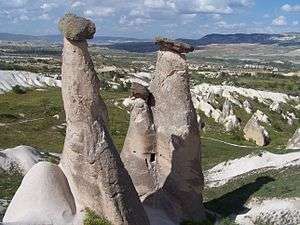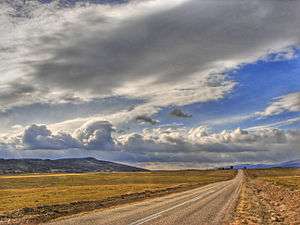Central Anatolia
Central Anatolia (Turkish: İç Anadolu) is a region of Turkey. It occupies country's central plateau, which is mostly a steppe.

Cities
- 🌍 Ankara — the second largest city in Turkey, capital of both the region and the whole country
- 🌍 Afyonkarahisar (also known as Afyon) — a traditional city with an impressive hilltop citadel
- 🌍 Aksaray
- 🌍 Çankırı
- 🌍 Divriği — site of elegant, Seljuk-built Great Mosque, a UNESCO World Heritage site
- 🌍 Eskişehir — a fairly liberal riverside university town with pleasant bridges and sculptures
- 🌍 Karaman — city midway between Konya and Adana, stopover en route to Northern Cyprus
- 🌍 Kayseri — large city near Mt. Erciyes, a wintersports resort
- 🌍 Kemerhisar — town close to ancient city of Tyana and mineral water springs
- 🌍 Konya — the site of Rumi's mausoleum, and many beautiful Seljuk monuments
- 🌍 Kütahya — town famous for its tile/faience tradition since Ottoman times; hub for visiting Temple of Zeus in Aizonai
- 🌍 Nevşehir — capital of Cappadocia
- 🌍 Sandıklı — town notable for its hot springs
- 🌍 Sivas — Site of a Seljuk Madrese complex, as well as the site of the Congress of Sivas that planned the Turkish War of Independence.
Other destinations
- 🌍 Aizanoi (Çavdarhisar) — if you're around, the immense Temple of Zeus of this ancient city is well worth a visit
- Beypazari — old town with Ottoman architecture on the silk road near Ankara.
- 🌍 Bogazkale — an ancient Hittite city
- 🌍 Cappadocia — a land of "fairy chimneys" and underground cities
- 🌍 Çatalhöyük — trace the earliest steppes of the civilization, and the idea of a city in this World Heritage site
Understand
Apart from the obvious steppe landscapes and the moonscape of Cappadocia, Central Anatolia offers a wealth of sights dating back to a diverse array of civilizations.
While the locals of the region nowadays are by and large known for their conservative worldview, pockets of youth-, and tourism-driven liberalism in Ankara, Cappadocia, and most particularly in the university town of Eskişehir make the contemporary culture of the region a quite diverse one.
History
Çatalhöyük, which existed approximately between 7500 BC and 5700 BC in the steppes east of Konya, was the first settlement ever found in the territory of what is Turkey today, and indeed it was one of the oldest spots with a sedentary lifestyle in all of the World.
The first major state that rose to power in Central Anatolia was the Kingdom of Hittites, an ancient Indo-European speaking nation and contemporary (and often at war) with Pharaonic Egypt. Hittites occupied most of Central Anatolia as well as large chunks of neighbouring regions, as far south as Syria.
Later in 10th century BC, Phrygians arrived from northwest, most likely from Thrace in southeast Balkan Peninsula, settling in the western reaches of the region. Phrygians had carved still-impressive open air temples on the sides of sacred mountains for their mother goddess Cybele.
Invaded consequently by Lydians from west and Persians from east, the region was then run over by the army of Alexander the Great on the way to India, who cut the famous Gordian Knot in Gordion, ruins of which now lie 60 km west of Ankara, near Polatlı.
Then came the Celts in 278 BC, who once occupied all across Europe from British Isles to Central Anatolia, and founded the Kingdom of Galatia in central northern parts of the region. They were defeated by Romans, who kept the name and administered the region as the Province of Galatia.
Central Anatolia, Cappadocia in particular, was one of the hideouts of often-oppressed early Christians, who established underground cities and hidden churches to avoid persecution. Byzantines kept the tradition of turning natural landscape of Cappadocia into a religious one, with gorgeously painted churches chipped into naturally-occurring "fairy chimneys".
After the Battle of Manzikert of 1071 which took place in Eastern Anatolia, Turkic tribes started to appear in Central Anatolia, which is indeed the region with the longest history of Turkic settlement in what is now Turkey, possibly due to the similarity of the region to their homeland in Central Asia in terms of geography and climate. Tribes united into Sultanate of Rum (Seljuqs), which had its heartland in the region.
After the demise of the Sultanate, the regional administration dissolved into a number of smaller emirates, out of which an outsider one, Ottomans, took over all others one by one. During most of the period of Ottoman Empire, which centred itself more on Marmara Region and Balkans, the region was seen as a backwater—which may explain the absence of large scale Ottoman monuments in the region—integrating with outside markets only in the late 19th century with the arrival of Berlin–Baghdad railway, one of the most ambitious projects of the age of colonialism.
Climate
Temperate continental with four distinct seasons, although spring and autumn tend to be short transitional periods between summer and winter. Winters are often snowy and well below the freezing point, and temperatures down to -20°C are not uncommon, but it is the eastern bits of the region that sees the lower numbers in thermometer. However, given the lack of humidity due to the total absence of maritime influences, it actually feels less cold than coastal cities such as Istanbul unless it is lower than -10°C. Summers are characterized by sunny and hot-but-not-sticky days, cool evenings, and chilly nights. Spring tends to be the rainiest season, but with an annual rainfall amount totalling to a little more than desert climates, you are unlikely to be met with heavy rainstorms anywhere in the region.
Get in

- While Ankara's Esenboğa is the main international airport in the region, it's not on par with most other airports of capital cities of the world with a little number of international connections and you usually have to transfer via one of Istanbul's airports when approaching from out of country. Konya, Kayseri, and Sivas also have airports with fairly frequent domestic services.
- Ankara is well-served by passenger trains from almost anywhere in the country with a rail line. Most lines have at least one service every day. Eskişehir is served by trains from northwest and west to Ankara, while trains from east pass through Sivas and Kayseri first on their way to Ankara. Trains from south also pass through Kayseri.
- Well-paved and wide highways, and usually those in motorway standards, connect the region to all directions.
- This is a landlocked region and irregular flow of the rivers don't let boats to navigate along, though you may try your chance with a canoe, instead.
Get around
See
- Most cities in the region, especially Konya, Kayseri, and Sivas, have a large number of Seljuq-built monuments, which are known for their majestic portals and exquisite stone masonry.
- Tuz Gölü (literally Salt Lake) is located in the very centre of Central Anatolia, between Ankara, Konya, and Aksaray, and is Turkey's second largest lake after Lake Van, although only about 2 (yes, two) meters deep at most. During summer months, it literally evaporates and leaves behind a flat and completely white landscape, just like a salt desert. You can walk around or even harvest salt with your own hands. It's also a good spot for birdwatching as it's an important stop-over for migratory birds on their route from Europe to Africa and vice versa during spring and autumn. Don't forget to bring good shoes and sunglasses as the already-shiny sun reflects to eyes double stronger with the extra power it obtains from saltpan.
- Karapınar Desert — while vast steppe landscapes that are yellow in summer as far as eye can see can satisfy most travellers, those yearning for a true patch of desert should check out Karapınar, an almost totally deserted town on the edge of a sand desert (with dunes and all) some 170 km southeast of Konya. Dunes at the desert form a dramatical backdrop for wooded zone, heavily afforested starting from 1970s to avoid further expansion of the desert.
Do
Eat
Most of the local cuisine depends on wheat and mutton, two major agricultural products of this arid steppe region. Cappadocia, however, features some vegetable-based local food thanks to its more fertile soil and the Macedonian immigrants who were settled in the area in 1920s.
Drink
Stay safe
Beware of ticks (kene) in the northern parts of the region (the rural areas of Tokat, Amasya, Çorum, Yozgat and Sivas Provinces), between April and October when they are active. The area is home to the ticks that belong to the Hyalomma genus, which are known to be a vector for the fatal Crimean-Congo hemorrhagic fever (CCHF, Turkish: Kırım Kongo Kanamalı Ateşi or KKKA). Not all ticks in the region belong to this genus, but if you are unfortunate enough to be bitten by one, attend a hospital immediately, preferably with the tick itself (experts advise against removing it from your body yourself as this may result in its mouth breaking apart which may rise the likelihood of an infection and makes it harder for the medical staff to correctly identify the tick).